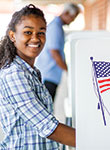
Five Tips on Engaging Student Voters
 By: Kim Grosenbacher, Boerne ISD
By: Kim Grosenbacher, Boerne ISDA midterm election year is a great time to teach students about the political process! US government teacher Kim Grosenbacher shares her tips on engaging students during an election
season and encouraging them to vote.
- Become a volunteer voter registrar.
Contact your local election office and become a volunteer voter registrar so you can personally register the eligible students (and staff!) at your high school. Students can register in Texas when they are 17 years and 10 months old. This will help students who turn 18 between the election date and the 30-day voter registration deadline. Have students research the voter registration process at votetexas.gov. - Share local sample ballots with your students.
It’s important for students to understand that they are voting for not only congressional candidates but also state and local candidates. Democracy only works when people actively participate in it. - Help students discover their political ideology.
Have them go to isidewith.com to take a political ideology quiz that will align them with a particular party during the midterm elections. This will give them a starting point in researching and seeking out the candidates that align with the party they identify with. Another ideology quiz to use with your students is the Political Typology Quiz. This quiz is narrow but allows your students to see another perspective as to where they fall on the political spectrum. - Have students research the candidates.
Students should research the current candidates and the issues they are supporting. Don’t reinvent the wheel—use resources that are designed to help you teach the election. I have students research the major state and US candidates for the Senate and House of Representatives, as well as the Texas Governor. They are required to come up with speaking points on why they would vote for that particular candidate. The League of Women Voters is a great resource. Students can use the voting guide at vote411.org to research Texas races and to create a personalized ballot based on their research. I use the Election Central link at realclearpolitics.com to track key races in other states. This allows students to see the bigger picture across the nation as key midterm elections may change the balance of power. Using this site, as a class, we can make predictions and research candidates in other states to reinforce our country’s unique concept of federalism and how it shapes our national politics. - Engage in classroom discussion and debate.
Now that your students are familiar with the candidates and their issues, it’s time to discuss and debate. Pose a question on an issue or a candidate and ask students to argue a side. Explain that everyone has a right to be heard and that your classroom is a safe learning environment in which to share opinions. I challenge my students to come up with three speaking points on why we should vote for their candidate. During each class, you can randomly call on students to share their speaking points and to convince the class why we should vote for their candidate. I use a randomizer app called ClassDojo. This is a great teaching tool that helps organize how many times I call on a student—which keeps my students engaged and ready to answer questions!
Kim Grosenbacher is an AP/dual credit US government teacher at Champion High School in Boerne.
